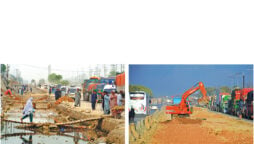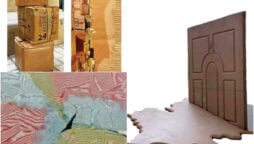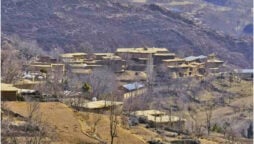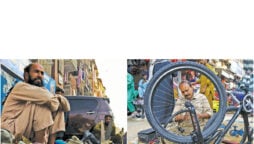
Bamboo craft
Future architects design relief shelters for flood victims
Students of Architecture Programme, Visual Studies Department, University of Karachi have proved that “necessity is the mother of all invention”, by designing lightweight houses, built from locally available materials, to rehabilitate the victims affected by floods.
As painful as it may sound, one-third of the country is submerged in water. According to National Disaster Management Authority, the continuous flooding since mid-June has completely damaged over 370 thousand homes while 730 are partially damaged.
Around eighty-eight per cent of the damage happened in Sindh. The sensitive intention to rehabilitate people with empathy is indeed an achievement.

The presented models by the Architecture Programme of the Visual Studies Department are considered economically efficient, environmentally friendly and culturally appropriate. The ideas are derived from the material research by the students.
The workshop was conducted under the supervision of 11 faculty members. Ten groups were formed, each having architecture students from different batches, allowing students to think and formulate their ideas cumulatively, utilising the available resources and learning with the process. The whole purpose was to encourage future architects to design and build for the needs of the people.
Students experimented with multiple ideas based on their research whereby some proposed detachable bamboo walls that can work as rafts too while others experimented with the idea of a floating house. Some even suggested that the whole structure should be elevated to allow inhabitants to shift on the first floor during inundation.
The students were even provided with a tentative cost estimation, based solely on materials, to highlight the economic aspect of their ideas.
Opting for bamboo and mud have several purposes, while these are eco-friendly materials, they are readily available and resonate with cultural and social context. Catering to the socio-cultural need is necessary as the idea is to find solutions that can make it easier for them to settle in the long run.
As of now, some 4000 people are provided with shelter, but the tents cannot withstand extreme weather conditions and it is not a viable solution in the long run because the open surroundings are not safe for the inhabitants, especially children. The unhealthy drinking water and the harsh environment make the matter even worse.
It may be mentioned here that bamboo is one of the fastest growing materials and highest yielding renewable natural resources and a good substitute for wood, especially in Pakistan where the business of illegal timber survives and thrives on corruption, violence and bullying. Keeping in view the existing conditions in the country, such a plan can surely be executed for mass production especially, in areas likely to face flood fury every year.

The local youth and villagers can also be trained, to build such units themselves, over a period of time. Comparatively, the construction of such homes takes less time as well. Here it’s pertinent to point out that according to a report recently published in Green Gold Bamboo, bamboo has a great potential to solve the scarcity of sustainable building materials for high-end and affordable buildings in both urban as well as rural areas. Recent examples from Europe, South America and Asia have shown that bamboo can be used to make modern bridges, airports, and even luxury condominiums in addition to affordable, culturally sensitive, flood affected and earthquake-resistant small family homes.
Further recommending bamboo houses the report adds, “The Philippines has some of the poorest people in the world whose troubles are compounded by typhoons and floods. A global architectural design contest was floated to come up with ideas to face such natural calamities. One of the winning projects was ‘Disaster-Proof Bamboo Housing.”
According to a report published in September, the idea of a bamboo house is in fact, not new in Pakistan. Yasmeen Lari, Pakistan’s first female architect delivered bamboo-built relief shelters to the flood-affected countryside in similar circumstances in 2010.
She helped organise the building of thousands of these bamboo huts, which along with being progressively up-gradable depending on the longevity of the displacement. These ended up withstanding floods in 2012 and 2013, at which point some had even been raised on bamboo stilts.
According to newspaper reports, while millions of flood survivors are still shelter-less or marooned in their villages, hundreds of families have arrived in Karachi to take shelter in government schools in the suburbs of the city. With no shelter, no food, and no land to stand on, the flood-affected people have no option but to seek refuge in cities till flood water recedes.

They are confined to the schools as they do not have any money to go out and buy food. They say, “All political parties are talking about the devastation caused by the floods, but no one is stepping forward to help the victims.”
The survivors believe the horrific memories of this catastrophe would haunt them for the rest of their lives, while the future of their children is also at stake. “Our houses have been washed away in front of our eyes. If we had not come to Karachi, the floodwater would have swept us away too,” they told a local daily reporter with teary eyes.
Now even if the flood water recedes in a month or so, will they be able to get their houses back fully intact remains the biggest question. It’s high time the NGOs and the government pool their resources and translate the concept of bamboo houses, presented collectively by the up-and-coming architects of Karachi, into a reality.
Catch all the Urban Insight News, Breaking News Event and Latest News Updates on The BOL News
Download The BOL News App to get the Daily News Update & Live News.












 Read the complete story text.
Read the complete story text. Listen to audio of the story.
Listen to audio of the story.